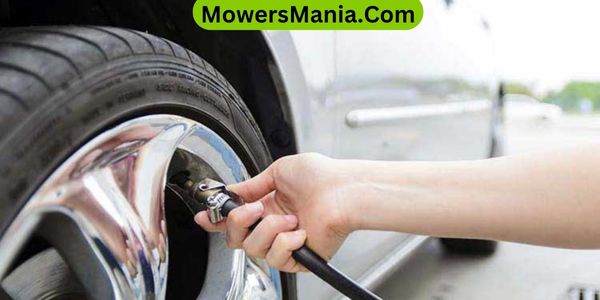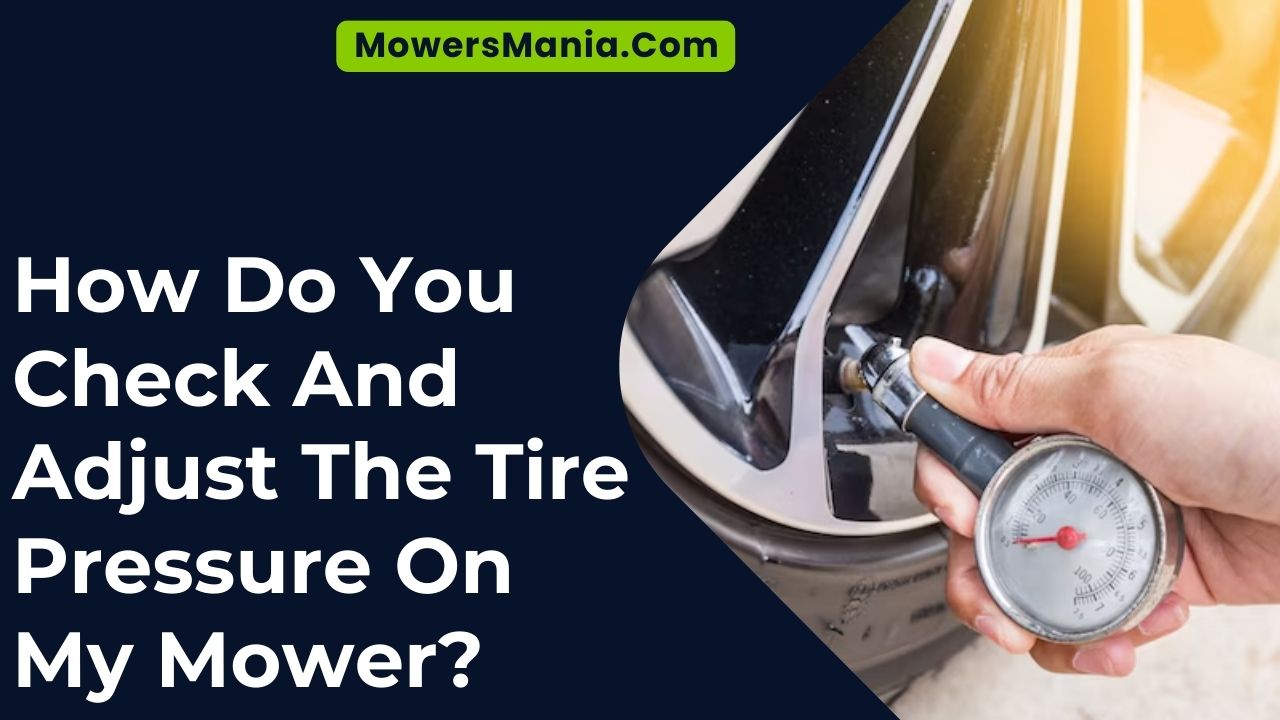You may think that checking and adjusting tire pressure on your mower is as easy as, well, mowing the lawn. But getting it right is more important than you might realize.
The last thing you want is to end up with an uneven cut or, worse, damage your mower due to improper tire pressure.

So, let’s start with the basics and ensure your mower’s tires are good to go.
Importance of Proper Tire Pressure
To ensure optimal performance and longevity of your mower, maintaining the correct tire pressure is crucial. Proper tire pressure ensures that the weight of the mower is evenly distributed across all tires, preventing uneven wear and potential damage.
When the tire pressure is too low, the tires may not be able to support the weight of the mower effectively, leading to increased friction, higher fuel consumption, and potential overheating.
Conversely, overinflated tires can result in a rough and uncomfortable ride, reducing traction and causing premature wear on the tire treads.
Additionally, maintaining the correct tire pressure also contributes to the overall stability and maneuverability of the mower.
Insufficient tire pressure can lead to poor handling and increased risk of accidents, especially when navigating uneven or sloped terrain.
By ensuring that the tire pressure is at the recommended level, you can enhance the safety of operating your mower.
Regularly checking and adjusting the tire pressure of your mower is a simple yet essential maintenance task that directly impacts its performance and safety.
By keeping the tires properly inflated, you can maximize the efficiency and lifespan of your mower while ensuring a smooth and safe operation.
Tools Needed for Checking Tire Pressure
Maintaining the correct tire pressure, as discussed earlier, requires a few essential tools for checking and adjusting the tire pressure on your mower.
The primary tool you’ll need is a tire pressure gauge. This simple device allows you to measure the air pressure inside the tires accurately.
There are various types of tire pressure gauges available, including digital and analog models. Choose one that’s easy for you to read and use.
Additionally, it’s beneficial to have an air compressor at hand. This will enable you to add air to the tires if the pressure is too low.
Some air compressors come with built-in pressure gauges, which can be convenient for checking the tire pressure and inflating the tires to the correct level in one go.
Lastly, having a tire inflator with a built-in pressure gauge can be a practical tool to have. These inflators allow you to add air to the tires with precision while being able to monitor the pressure accurately.
With these tools in your possession, you’ll be well-equipped to regularly check and adjust the tire pressure on your mower, ensuring optimal performance and safety.
Steps to Check Tire Pressure

Start by positioning the tire pressure gauge onto the valve stem of the mower’s tire. Press the gauge firmly onto the valve to ensure an accurate reading.
Once the gauge is in place, take note of the pressure reading displayed. If the reading is within the recommended range specified in your mower’s manual, you’re all set.
However, if the pressure is too high or too low, adjustments are necessary. To add air, use an air compressor and attach the nozzle to the valve stem. If the pressure needs to be reduced, press the small pin in the center of the valve to release air.
After making adjustments, recheck the pressure to ensure it falls within the specified range. Repeat this process for each tire on your mower.
To further assist with the tire pressure check and adjustment process, refer to the table below for a quick and easy guide:
| Step | Action |
|---|---|
| 1 | Position gauge on valve stem |
| 2 | Read pressure |
| 3 | Add or release air as needed |
| 4 | Recheck pressure |
| 5 | Repeat for each tire |
Adjusting Tire Pressure
If necessary, adjust the tire pressure on your mower according to the recommended range specified in the manual.
To adjust the tire pressure, first, remove the valve cap from the tire valve.
Then, using a tire pressure gauge, check the current pressure of the tire.
If the pressure is too low, use an air compressor to add air until the pressure matches the recommended level.
If the pressure is too high, use the gauge to release air until it reaches the correct level.
It’s crucial to ensure that the pressure is uniform across all tires for even mowing and to prevent damage to the lawn.
Once the tires are inflated to the appropriate pressure, securely replace the valve caps to prevent dirt and debris from entering the valves.
Regularly checking and adjusting the tire pressure won’t only extend the life of your mower’s tires but will also ensure optimal performance and safety during operation.
Always refer to the mower’s manual for the specific recommended tire pressure range.
Maintenance Tips for Tire Pressure

When maintaining the tire pressure of your mower, remember to regularly check and adjust the pressure to ensure even mowing and prevent damage to the lawn.
Proper maintenance of tire pressure is crucial for optimal performance and longevity of your mower.
Here are some essential maintenance tips to keep in mind:
- Regular Inspections: Inspect the tires for any signs of wear and tear, such as cracks, bulges, or punctures. Addressing these issues promptly can help prevent sudden tire failures and potential damage to the mower.
- Use a Pressure Gauge: Invest in a reliable pressure gauge to accurately measure the tire pressure. Check the manufacturer’s guidelines for the recommended pressure levels and adjust as needed.
- Seasonal Adjustments: Keep in mind that temperature changes can affect tire pressure. As the weather fluctuates, make seasonal adjustments to ensure the tires are inflated to the appropriate levels.
- Proper Storage: When storing the mower for an extended period, ensure that the tires are properly inflated. Improperly stored equipment can lead to flat spots on the tires, affecting performance when the mower is used again.
Frequently Asked Questions [FAQs]
Can I Use a Regular Tire Pressure Gauge for My Mower’s Tires?
Yes, you can use a regular tire pressure gauge for your mower’s tires. Make sure the gauge is suitable for the pressure range of your mower’s tires. Check the recommended tire pressure in the manual.
How Often Should I Check the Tire Pressure on My Mower?
You should check the tire pressure on your mower at least once a month. This will help ensure that your mower operates safely and efficiently. Adjust the pressure as needed to the recommended level in the manual.
What Are the Consequences of Having Incorrect Tire Pressure on My Mower?
Incorrect tire pressure on your mower can lead to uneven wear, poor traction, and potential damage to the wheels. It may also affect the overall performance and maneuverability, so it’s important to regularly check and adjust the tire pressure.
Is There a Specific Tire Pressure Range I Should Aim for With My Mower’s Tires?
You should aim for a specific tire pressure range with your mower’s tires. Check your mower’s manual for the recommended tire pressure. Avoid overinflating or underinflating, as it can affect the mower’s performance and cause uneven wear on the tires.
Are There Any Common Signs That Indicate My Mower’s Tires Need to Be Inflated or Deflated?
If your mower’s tires look visibly deflated or overinflated, that’s a sign they need adjusting. Also, if your mower feels unstable or the steering is off, it could indicate the tire pressure needs attention.
Conclusion
Now that you know how to check and adjust the tire pressure on your mower, you can ensure that it runs smoothly and efficiently.
Proper tire pressure is essential for maintaining traction and stability, as well as preventing unnecessary wear and tear on your mower.
By regularly checking and adjusting the tire pressure, you can extend the lifespan of your mower and enjoy a better mowing experience.



